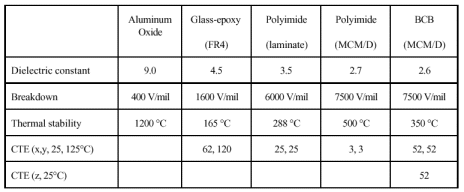| |
Terminologie
a některé další zkratky
Microwave MCM-D
MCM-D technology is well suited for high-frequency
applications, particularly due to its
high precision and possibility to integrate re-sistive
and capacitive layers. Oriented towards integrating the whole front-end
RF of wireless communications systems
in one single package.
PWB, HD-PWB
podobné: printed circuit board (PCB),
Neboli Printed Wiring Board, nebo dnes novější technologie prozaicky nazvaná High Density-PWB. Tato technologie využívá jako podklad bud keramiku, nebo skleněnými vlákny vyztuženou epoxydovou destičku. Další vývojový krok by měl být
"high-density flex, polyimide based technology", která vypadá asi následovně:

Tato destička je asi 300um tlustá, ctyřvrstvá. Z toho dvě vrstvy jsou pro signálové cesty, izolační vrstva a vrchni vrstva pro montáž I/O.
Nevýhodou polyimidů byla náchylnost k vlhnutí. V součastnosti se však již podařilo tuto nevýhodu odstranit. Parametry: Nevratná absorbce vody: 0.2%; dielektrická konstanta: 2.8; nejmenší tloušťka vrstvy 5-10um.
Porovnání obvyklých technologií

Known Good Die (KGD)
One of the key elements determining the success of miniaturized electronic systems is
the availability of the necessary components in a tested bare die form (KGD) or mini-mally
packaged components (chip scale package or CSP). Component availability,
level of goodness, handling, shipping and storage, as well as design data, test and
assembly are among the most urgent aspects to be addressed. In this field, IMEC is
leading a European funded program, the GOOD-DIE Network, which has started its
second phase of activities in November 1998. Results from the first phase include the
commercial launch in May of the GOOD-DIE service, a component database tailored
for the need of the MCM designer, providing high-level quality information on a large
number of KGD and CSP devices (www.gooddie.com). In the second phase, the objec-tive
of the network, now counting more than 600 members, is to increase the aware-ness
of the need for KGD and CSP throughout the industry and to disseminate infor-mation
related to KGD, CSP and HDPs. Another activity with CENELEC is to generate
a European standard for the exchange of data on KGD and CSPs (P142, C266).
More information on GOOD-DIE can be found at: www.imec.be/kgd
The polymer stud grid array package (PSGA)
The PSGA is a novel packaging concept, jointly developed by IMEC and Siemens. The
PSGA is an area array package which uses metallized plastic studs, moulded to the
body of the package, instead of large solder balls as with ball grid array (BGA) pack-ages.
This results in a more reliable and cost effective package. The nearly cylindrical
studs have a higher aspect ratio (height -- diameter ratio) than the solder balls of BGA
packages. This makes this package concept well suited for chip scale and chip sized
packages with stud pitches of 0.8 to 0.5 mm (D3, P182, P183).
The PSGA and the technology for realizing PSGA packages is now being commercial-ized
worldwide by Siemens. IMEC works with Siemens on the further optimization
and characterization of the package as well as on novel concepts for chip sized pack-ages
with smaller pitches. In the last year, a 72 pin cavity-up PSGA package with 0.8
mm stud pitch was realized
BGA
Ball grid arrary

|
|